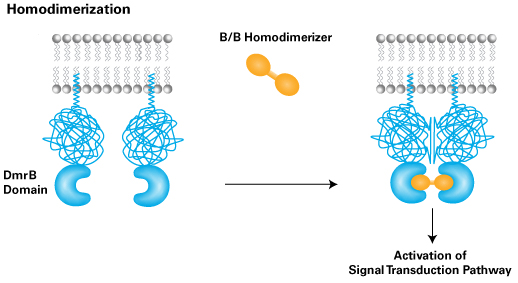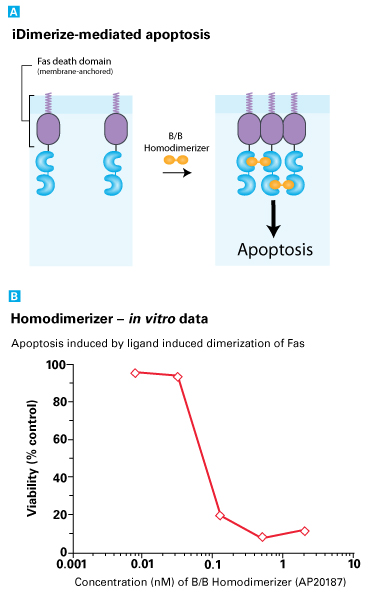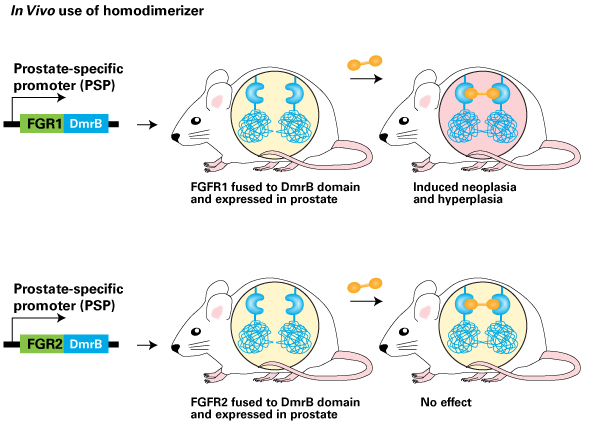| 제조사 |
제품코드 |
제품명 |
용량 |
가격
(부가세별도) |
비고 |
사용자매뉴얼 |
Clontech
|
635068
|
iDimerize Inducible Homodimer System



|
each
|
2,222,000원
|

|
 , ,
 , ,

|
Clontech
|
635058
|
B/B Homodimerizer



|
5 mg
|
1,286,000원
|

|
 , ,
 , ,
 , ,

|
Clontech
|
635059
|
B/B Homodimerizer



|
5 X 500 ㎕
|
1,056,000원
|

|
Clontech
|
635069
|
B/B Homodimerizer



|
25 mg
|
3,893,000원
|

|
Clontech
|
632622
|
B/B Homodimerizer



|
4 x 25 mg (635069 x 4)
|
17,519,000원
|

|
Clontech
|
635088
|
B/B Washout Ligand



|
500 ul
|
757,000원
|
재고소진 후 종매

|
 , ,
 , ,
 , ,
 , ,

|
Clontech
|
635072
|
Lenti-X™ iDimerize Inducible Homodimer System



|
Each
|
2,423,000원
|

|
 , ,
 , ,
 , ,
 , ,
 , ,

|
Product index
-
Tet 유도 발현 시스템
-
iDimerize Inducible System..
-
단백질 발현량 조절 시스템 ..
-
[개요] Yeast Hybrid System
-
Yeast Two Hybrid System (Y..
-
Yeast One-Hybrid (Y1H)
-
Matchmaker 관련제품
The iDimerize Inducible Homodimer System brings protein-protein interactions under real-time, small molecule control. A protein of interest is
fused to the DmrB binding domain, and dimerization is induced by adding the B/B Homodimerizer (AP20187). This cell-permeable ligand induces
two or more copies of the DmrB fusion protein to interact. iDimerize Inducible Homodimer technology has been used to create conditional
alleles of cell surface receptors, signaling molecules, and other proteins which are regulated by protein-protein interactions.
Induced protein homodimerization is already widely used in vitro and in vivo to control signaling pathways, and it can be used to induce any
type of event that is activated or controlled by protein-protein interactions, including proliferation, differentiation, adhesion, transformation,
and apoptosis.
Note: While it is possible to use the iDimerize Inducible Homodimer System to induce heterodimerization, you will obtain a mixture of
homodimers and heterodimers. To induce heterodimers specifically and exclusively, use the iDimerize Inducible Heterodimer System.
 Figure 1. Mechanism of the iDimerize Inducible Homodimer System. Fusion proteins containing the DmrB domain do not interact until
the B/B Homodimerizer is added. This cell-permeant ligand induces the fusion proteins to interact, activating a downstream event in real time.
This example shows activation of a signal transduction pathway through dimerization of a cell surface receptor protein.
Figure 1. Mechanism of the iDimerize Inducible Homodimer System. Fusion proteins containing the DmrB domain do not interact until
the B/B Homodimerizer is added. This cell-permeant ligand induces the fusion proteins to interact, activating a downstream event in real time.
This example shows activation of a signal transduction pathway through dimerization of a cell surface receptor protein.
B/B Homodimerizer Ligand (AP20187)
The B/B Homodimerizer is a synthetic, cell-permeable ligand that can be used to induce homodimerization of fusion
proteins containing the DmrB domain. It is nontoxic in vitro and in mice (recommended dosage range,
0.01-100 nM for in vitro use or 0.005-10 mg/kg in mice). The B/B Homodimerizer is identical to the AP20187 ligand,
which was previously supplied by ARIAD Pharmaceuticals Inc.
Application: Signal Transduction
Many signaling cascades are activated almost exclusively by the interactions of signaling proteins. Cell surface receptor proteins cluster in response to
extracellular factors, which leads to the recruitment and activation of intracellular signaling proteins, transcription activation, effector protein production,
and finally to protein activation or secretion. Any step of this signaling pathway that relies on a dimerization event can be brought under dimerizer
control by fusing the proteins involved to the DmrB domain.
Example 1: Inducing a Programmed Cell Death Pathway (Inducible Apoptosis)
Example 2: Inducible Mouse Model for Prostate Cancer
Example 1: Inducing a Programmed Cell Death Pathway (Inducible Apoptosis)
The Fas receptor (FasR) is a transmembrane protein located on the surface of cells that activates programmed cell death (apoptosis)
when induced to trimerize by fas ligand (FasL) molecules located on the surface of adjacent cells (e.g., cytotoxic T cells).
FasR-FasL binding plays an important role in the regulation of the immune system and cancer progression. This trimerization
(and the resulting apoptotic signaling cascade) can be mimicked using the iDimerize Inducible Homodimer System: cells expressing
a FasR-DmrB fusion protein can induce cell death on demand, simply by adding the B/B Homodimerizer. An in vivo model
(the MaFIA mouse; 1) utilizes the Fas receptor to systematically and reversibly eliminate macrophages from transgenic mice.
 Figure 2. Fas-induced apoptosis in vitro. The fas receptor (FasR), once trimerized, activates an apoptosis pathway.
Programmed cell death can be mimicked at will by transfecting cells with a construct encoding the FasR-DmrB fusion protein
(Panel A, left) and treated with B/B Homodimerizer to induce trimerization (Panel A, right). Less than 1 nM B/B Homodimerizer
was sufficient to induce maximal cell death in these cells (Panel B; data kindly provided by ARIAD Pharmaceuticals, Inc.).
Figure 2. Fas-induced apoptosis in vitro. The fas receptor (FasR), once trimerized, activates an apoptosis pathway.
Programmed cell death can be mimicked at will by transfecting cells with a construct encoding the FasR-DmrB fusion protein
(Panel A, left) and treated with B/B Homodimerizer to induce trimerization (Panel A, right). Less than 1 nM B/B Homodimerizer
was sufficient to induce maximal cell death in these cells (Panel B; data kindly provided by ARIAD Pharmaceuticals, Inc.).
Example 2: Inducible Mouse Model for Prostate Cancer
iDimerize Inducible Homodimer technology was used to characterize the role of different FGF receptor subtypes (FGFR1 and FGFR2)
in prostate cancer. Transgenic mice (which express conditionally active alleles of FGFR1 or FGFR2 in prostate tissue) were treated with
B/B Homodimerizer and monitored for prostate cancer. FGFR1, but not FGFR2, was found to play a role in prostate cancer development (2).
 Figure 3. Inducible mouse model for prostate cancer. Transgenic mice which expressed either FGFR1-DmrB or FGFR2-DmrB under
the control of a prostate-specific promoter were treated with B/B Homodimerizer and monitored for prostate cancer. FGFR1,
but not FGFR2, was found to play a role in prostate cancer progression (2).
Figure 3. Inducible mouse model for prostate cancer. Transgenic mice which expressed either FGFR1-DmrB or FGFR2-DmrB under
the control of a prostate-specific promoter were treated with B/B Homodimerizer and monitored for prostate cancer. FGFR1,
but not FGFR2, was found to play a role in prostate cancer progression (2).
Applications
- Induce any event or pathway that is controlled or activated by protein-protein interactions
- Activate signaling pathways in real time
- Study transmembrane receptors
- Recruit signaling proteins to specific subcellular locations (e.g. the plasma membrane)
- Inducible Homodimer technology has been used for functional studies of:
o Receptor and non-receptor tyrosine kinases
o Receptor and non-receptor serine/threonine kinases
o Non-kinase receptors
o Signaling proteases
o Adaptor proteins
o Cell adhesion and rolling
o DNA looping
o Activation of recombinase
o RNA splicing
o Protein splicing
o Glycosylation
References
1. Burnett, S. H. et al. (2004) J. Leukoc. Biol. 75(4):612-623. Conditional macrophage ablation in transgenic mice expressing a Fas-based suicide gene.
2. Freeman, K. W., et al. (2003) Cancer Res. 63(23):8256-8563. Inducible prostate intraepithelial neoplasia with reversible hyperplasia in conditional FGFR1-expressing mice.
Keyword : ARGENT Regulated Homodimerization Kit







